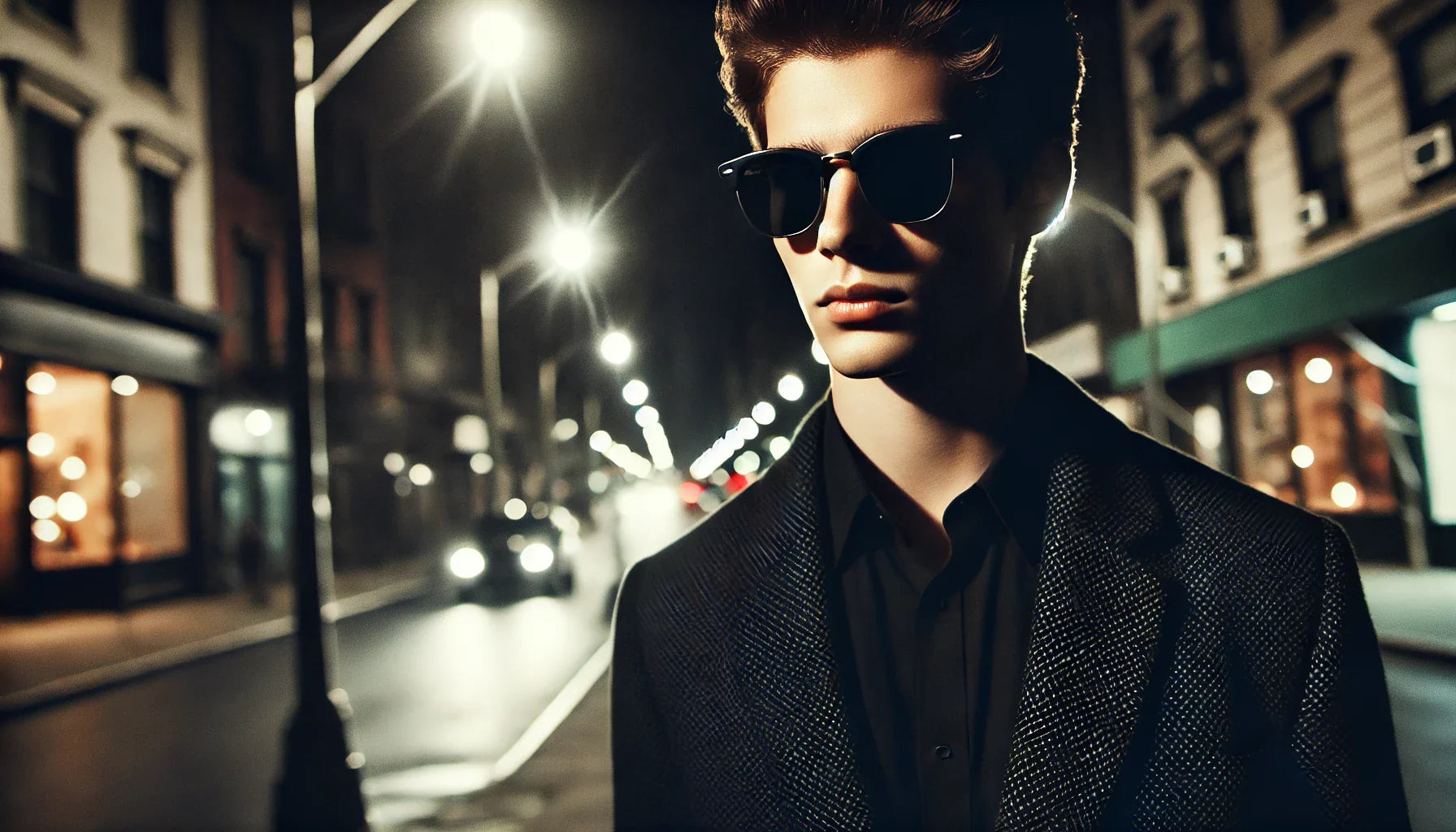Sunglasses. Our trusty companions, shielding our eyes from the sun's rays and adding a touch of cool to any outfit. But what about rocking shades after dark? Is it a fashion statement or a recipe for disaster (think someone tripping over a curb because they can't see)?
Like most things in fashion, the answer is a bit more nuanced. Buckle up, because we're about to dive into the definitive answers to this timeless question: are sunglasses at night good or bad? Let’s see!
Nighttime Navigation: Seeing Clearly in the Dark
Our ability to see clearly at night hinges on a delicate dance between darkness and our eyes' ability to adjust. Rods and cones, the light-sensitive cells in our retina, work together to provide vision in varying light conditions. Rods excel in low-light environments, while cones dominate in bright light. However, transitioning between the two takes time – a phenomenon known as dark adaptation.
Here's where sunglasses come in. Studies by the American Academy of Ophthalmology show that dark lenses significantly reduce the amount of light reaching the retina. This disrupts dark adaptation, making it difficult to see clearly in low-light conditions like nighttime.
So, if safety and clear vision are your priorities at night, ditch the dark lenses.
Light Transmission Matters:
Highly Tinted Lenses (Less Than 50% Light Transmission): These lenses can cause blurry vision and pose safety hazards at night due to significantly reduced light reaching the retina. Research from the National Eye Institute (NEI) suggests a minimum light transmission of 70-80% is necessary for safe nighttime vision.
Lightly Tinted Lenses (50-80% Light Transmission): Rose-gold, amber, or light brown tints offer a subtle color enhancement while allowing a good amount of light for decent nighttime vision, especially during dusk or on brightly lit streets.
Clear Lenses : Not technically sunglasses, but clear lenses with anti-reflective coatings can be surprisingly beneficial at night. Research published in the Optometry Journal shows they can significantly reduce glare from headlights and oncoming traffic, improving visual comfort.

Night Driving Considerations
Studies from the National Highway Traffic Safety Administration (NHTSA) demonstrate that certain colored lenses, like yellow or amber, may improve contrast and depth perception in low-light conditions often encountered while driving at night.
A 2019 study published in Accident Analysis & Prevention found that yellow lenses enhanced drivers' ability to detect pedestrians at night compared to clear lenses. However, the NHTSA cautions against relying solely on colored lenses to enhance nighttime vision, emphasizing the importance of properly functioning headlights and following safe driving practices.
Beyond Light Transmission: Material and Coatings
The material and coatings of your nighttime sunglasses also play a role:
Polarized Lenses : These lenses significantly reduce glare by blocking scattered light waves, which can be particularly bothersome at night from headlights, reflective surfaces, and even wet roads. A 2017 study in the journal Optometry found that polarized lenses improved visual comfort and reduced eye strain during nighttime driving compared to non-polarized lenses.
Additional Considerations for Nighttime Vision
Age : As we age, our ability to adapt to darkness diminishes. This can make nighttime vision with sunglasses even more challenging for older adults.
Underlying Medical Conditions : Certain medical conditions, like cataracts or glaucoma, can further impair nighttime vision. Consulting your ophthalmologist before wearing sunglasses at night is recommended if you have any pre-existing eye conditions.

Beyond Sun Protection: Unveiling Unexpected Benefits
While sun protection reigns supreme, there are surprising benefits to consider when sporting clear-lens sunglasses at night :
Reduced Glare : Cityscapes are awash with bright lights, car headlights, and reflective surfaces that create glare. A 2020 study in the journal Ophthalmology found that clear lenses with anti-reflective coating significantly reduced glare, improving visual comfort, especially in environments with intense artificial lighting.
Eye Strain Relief : Evenings spent glued to digital screens expose our eyes to blue light, a specific wavelength that can contribute to eye strain. Research published in the Investigative Ophthalmology & Visual Science suggests that clear or lightly tinted lenses at night may offer a subtle barrier, reducing eye fatigue caused by prolonged screen exposure.
Sensitivity to Light : Individuals with photophobia, a medical condition characterized by light sensitivity, may find sunglasses helpful at night to manage discomfort from bright lights.
Style with Substance: Mastering the Nighttime Shades Look
Can sunglasses be a stylish evening companion? Absolutely! But achieving a fashion-forward look requires a strategic approach:
Frame Flair : Opt for statement silhouettes – oversized wayfarers, bold cat-eyes, or trendy geometric shapes – to add instant drama and intrigue. Think oversized wayfarers reminiscent of the 80s or dramatic butterfly frames that channel a glamorous old-Hollywood vibe.
Embrace the Retro Vibe : Round or oval frames with clear lenses evoke a vintage aesthetic, channeling a 70s vibe or adding a touch of intellectual coolness. Look for classic panto or teashade styles. Panto frames feature slightly rounded lenses with a keyhole bridge, while teashade styles have slightly wider, flattened lenses that offer a sophisticated touch.
Material Matters : Elevate your look from casual to chic with luxurious materials like tortoiseshell acetate or sleek metal. Acetate frames offer a vintage touch, reminiscent of iconic styles from the past. Metal frames exude a modern aesthetic, perfect for a minimalist or edgy look.
Confidence is Key : When rocking sunglasses at night, ensure your outfit complements your shades. Pair them with a sleek jumpsuit, a little black dress, or a tailored suit for a head-turning look. Don't forget to consider your hairstyle and makeup – bold sunglasses can be the finishing touch to a complete and confident statement.

The Final Verdict: So, Are Sunglasses at Night Good or Bad?
So, can you wear sunglasses at night ? Like most things in fashion, the answer is "it depends." Here's a breakdown to help you decide:
For Safety and Clear Vision at Night: Ditch the dark lenses and opt for clear lenses with anti-reflective coating or lightly tinted lenses (50-80% light transmission) for improved nighttime visibility, especially during dusk or on brightly lit streets. Consider polarized lenses for additional glare reduction.
For Style and Glare Reduction: If clear vision isn't your top priority, and you're in a well-lit environment, then lightly tinted or clear lenses with anti-reflective coating can add a touch of style while reducing glare from city lights or screens.
For Driving: Certain colored lenses, like yellow or amber, may offer some benefits for nighttime driving by enhancing contrast and depth perception. However, prioritize properly functioning headlights and safe driving practices over relying solely on colored lenses.
Ultimately, the choice is yours!
LookerOnline offers a curated collection of designer sunglasses, featuring a variety of lens tints, coatings, and frame styles to find the perfect pair that complements your nighttime look and personal needs.
So, are sunglasses good or bad at night? It depends on the situation and your priorities. With the information above, you can make an informed decision prioritizing safety and style.
Sources:
- American Academy of Ophthalmology (AAO): https://www.aao.org/newsroom/news-releases/detail/sunglasses-your-prescription-eye-health
- National Highway Traffic Safety Administration (NHTSA): https://www.nhtsa.gov/
- National Eye Institute (NEI): https://www.nei.nih.gov/
- Optometry Journal: https://www.abdo.org.uk/wp-content/uploads/2013/06/80.pdf (Link discusses a webinar on spectacle lenses for driving)
- Accident Analysis & Prevention: https://www.ncbi.nlm.nih.gov/pmc/articles/PMC6681548/
- Ophthalmology Journal: https://www.ncbi.nlm.nih.gov/pmc/articles/PMC6681548/ (This link may be the same study from Accident Analysis & Prevention)
- Investigative Ophthalmology & Visual Science: https://pubmed.ncbi.nlm.nih.gov/37593770/





